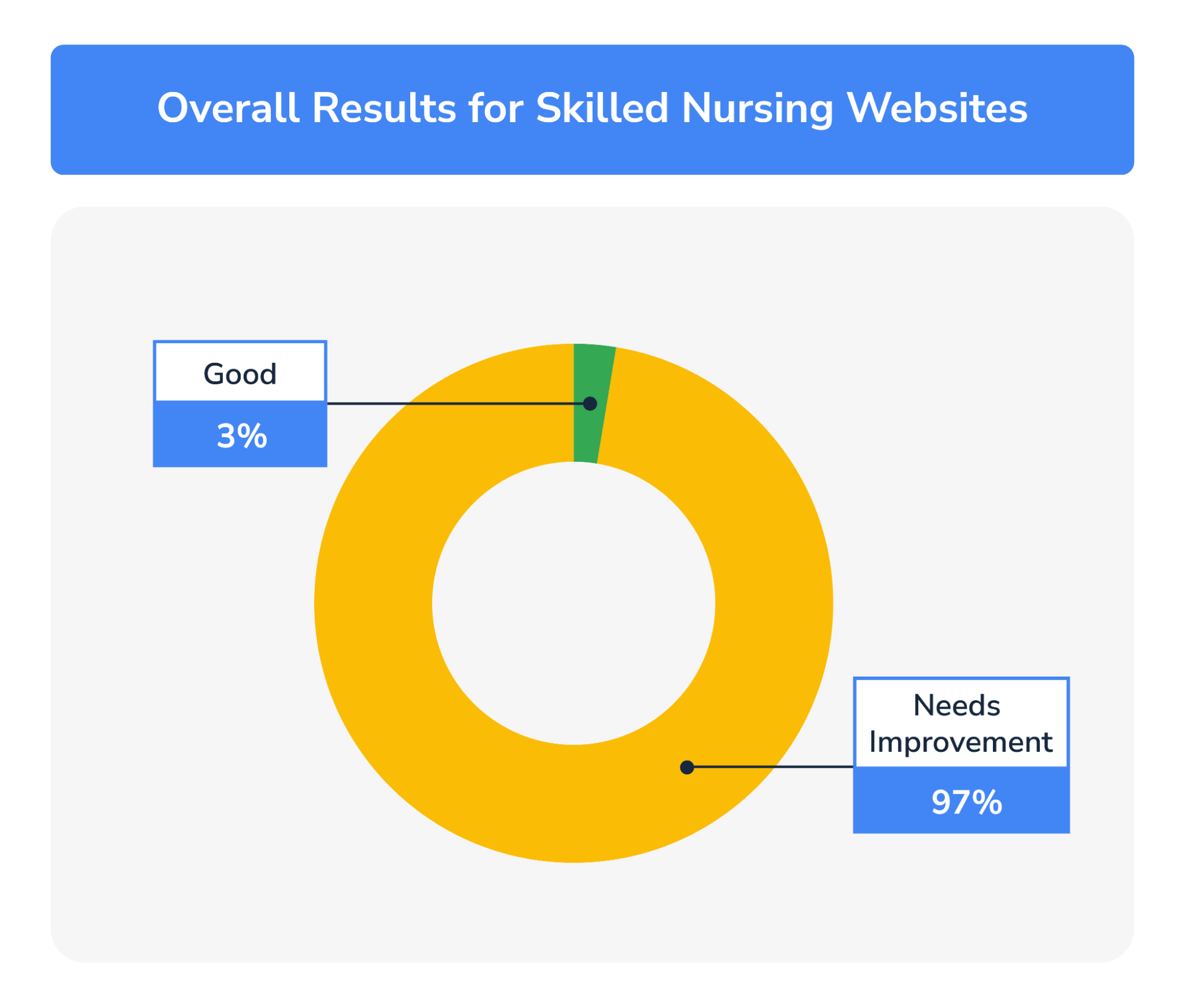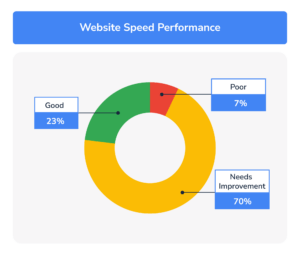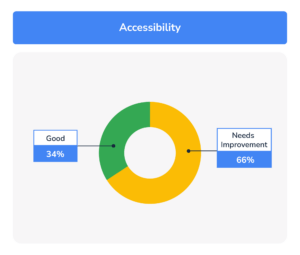

Websites in the Skilled Nursing Industry Suffer from Poor Performance
Findings from a DBS Interactive study reveal skilled nursing websites score poorly in tests for performance and accessibility. The review evaluated about 200 random websites for companies across the country.
Only five websites included in our study scored between 90 and 100 in all four metrics in the Google Lighthouse: Performance, Best Practices, Accessibility, and SEO. Of those, only one website was built as a progressive web application, a fifth criterion for a higher-performance website.
The analysis looked at websites for 193 facilities in major cities. (See the scores)
Websites are often the first encounter with a skilled nursing facility. While patients or their families are primary audiences, these businesses struggle daily to fill open jobs and to attract investors or partners.
A low-performance website turns away all audiences.
Performance Woes
The performance component of the Google Lighthouse test evaluates various aspects of a website's page-loading time.

Winning top search rankings requires web developers with technical SEO expertise.
Fast-loading websites offer quick access to critical information such as facility details, healthcare services, and contact information. Patients and their families visit these websites, often in times of stress, seeking time-sensitive information, and a slow-loading site may impede their ability to access vital resources quickly.
That’s not the case for many of the websites in this evaluation.
Over 75% of the skilled nursing sites tested fell into the needs improvement and poor groups.
The majority of those sites scored between 50 and 89 for the “Needs Improvement” performance range, while 7% of the websites turned in scores designated “Poor”.
The lowest performance score was 28.
At the other end of the spectrum, two websites, Spring Hill Rehabilitation and Nursing Center in Pittsburgh and Fairfax Health Care Center in Cleveland turned in scores of 100 for performance.
Google research confirms that website visitors lack patience. The company found bounce rate probability increased by 32% as page load times increased from one to three seconds.
Accessibility Non-Negotiable for Skilled Nursing Sites
The persistent issue of poor website accessibility scores poses a significant challenge, particularly within the skilled nursing industry. Individuals recovering from stroke or surgery, and the aging population with reduced vision.

Beyond ADA compliance, an accessible website supports organic search performance.
In this study, 66% of the websites scored between 50-89 for Accessibility, putting them in the “Needs improvement” category. At the low end, three websites scored 65, while seven websites scored 100.
“We’ve seen low accessibility scores across all industries, with problems ranging from missing alt text and poor color contrast to inaccessible form controls and keyboard navigation issues,” said John Golden, Director of Development at DBS Interactive.
Search engines recognize the need for this level of user experience. Accessibility is known to benefit websites for organic search performance.
Low accessibility scores also raise a red flag for legal departments always on alert for avoiding lawsuits. The Americans with Disabilities Act has been interpreted to include websites just as it requires accessibility for physical places.
Despite lawsuits against notable companies like Domino's Pizza, Target, and Harvard University, companies have not come around to building and maintaining a website that complies with the Americans with Disabilities Act (ADA). Today that generally means the WCAG 2.1 AA criteria.
Benefits of an Accessible Website
- Improved search engine performance
- Positive brand reputation
- Faster user experience
- Improved user pathways
- Attracts and serves a wider audience
- Reduced legal exposure
Any Lighthouse score below 90, means the website could be a target of a lawsuit.
combine with UX View Our Healthcare Portfolio
About the Website Study
DBS Interactive, a full-service digital agency in Louisville, Ky., reviewed 193 websites for skilled nursing companies in January 2024, selected randomly for cities throughout the U.S. The results match previous studies for the websites of industrial companies, indicating that the lack of adherence to best practices is common.
Evaluations were done on the mobile component of the Lighthouse tool because Google considers that over the desktop for organic rankings.
Quick Facts
- 44 websites scored “Good” (above 90) for Performance
- 14 websites scored “Poor” (below 41) for Performance
- 5 websites scored above 90 for all four test components
- 4 websites were built as Progressive Web Apps (PWA)
- Over half of the sites need improvement for SEO performance
“Addressing performance issues and enhancing accessibility not only ensures compliance with digital standards but also positions businesses for sustained success in the competitive digital landscape,” said Cyndi Masters, CEO and Founder of DBS Interactive.
As skilled nursing companies navigate the competitive digital landscape, the study highlights the need for a proactive approach to web development. Addressing performance issues and enhancing accessibility ensures compliance with digital standards and positions businesses for sustained success
Six websites out of 193 sites tested achieved aggregated scores above 90.
| Facility/Business Name | Performance | Accessibility | Best Practices | SEO |
| Forest Street Compassionate Care Center. External Link. Opens in new window. | 98 | 99 | 100 | 92 |
| The Terraces At Skyline. External Link. Opens in new window. | 96 | 97 | 91 | 92 |
| Pioneer House The Riverview. External Link. Opens in new window., | 98 | 100 | 100 | 100 |
| Ignite Medical Resort Kansas City, LLC. External Link. Opens in new window. | 97 | 100 | 95 | 92 |
| Gregory Ridge Health Care Center. External Link. Opens in new window.. | 95 | 100 | 100 | 100 |
| Regency Integrated Health Services. External Link. Opens in new window. | 96 | 100 | 100 | 100 |
The Mobile Experience Matters
Another finding in the study revealed only four websites incorporated the Progressive Web App (PWA) technology.
As more users access websites from mobile devices, performance optimization becomes essential.
 Forest Street Compassionate Care Center and Regency Integrated Integrated Health Services were the only two of the six top-performing websites built as progressive web apps.
Forest Street Compassionate Care Center and Regency Integrated Integrated Health Services were the only two of the six top-performing websites built as progressive web apps.
Google Lighthouse evaluates a website's performance on mobile devices, emphasizing the need for responsive design and efficient loading times to cater to the growing mobile user base.
Websites built as PWAs are faster, more responsive, and capable of performing like an app, yet can still be indexed for search and usable as a traditional website. The architecture of a PWA supports a better user experience.
PWA Benefits
- Fast loading time
- Operates on poor networks
- Small development footprint
- Integrates app-like features
- No app stores, no downloads
- Instant updates
Here are easy-to-follow instructions for running the Google Lighthouse tool.
Optimize Website to Maximize Ad Impact
Companies may be wasting money with a low-performance website. Many skilled nursing companies rely on paid digital advertising to boost their position in search results. With relatively low clickthrough rates of about two percent for these ads, a company can’t afford to drive away patients or potential employees with a low-performing website.
Websites with better performance deliver an optimal user experience and can achieve better results, including higher conversion rates and reduced bounce rates. Also, user experience impacts PPC ad Quality Score, which considers the user experience on the website. A score indicates that Google perceives the ad, landing page, or overall user experience as suboptimal.
Low Lighthouse Scores Affect PPC Quality Scores
- May be displayed lower on the search engine results page (SERP).
- Result in a higher cost per click (CPC). Google rewards advertisers with higher scores by offering lower CPCs.
- Can limit the effectiveness of your ad extensions, reducing their impact on ad visibility and user engagement.
- Produce fewer impressions and a lower click-through rate (CTR).
“Beyond paid ads, a website with top-notch Google Lighthouse scores slashes PPC spending and attracts more organic traffic. It's not just about ads; it's about optimizing the digital presence for maximum results," - said Steve Fowler, Marketing Director at DBS.
Keeping Your Website Healthy
The poor scores represent opportunities for skilled nursing facilities to implement performance improvements to their websites. Companies can document the results of the effort by tracking improved search rankings and higher click-through rates.
“The study signals a clear need for improvement with only five websites out of 193 achieving across-the-board scores above 90," said Cyndi Masters, CEO and Founder of DBS Interactive.
However, post-acute care companies are already stretched thin as they face the challenges of not having digital marketing and website development horsepower, which can justify hiring a multi-disciplined team like DBS Interactive with the expertise to design, build, and maintain a high-performance healthcare website.
“It’s an investment that benefits website visitors, and improving performance means it’s good for the bottom line,” she said.
While a company often tracks website performance with Google Lighthouse, Page Speed Insights, Google Trends, etc., most healthcare companies need additional expertise in the latest SEO trends and all of Google’s tools to improve search rankings, visibility, and user experiences.
Contact us about ways to improve your skilled nursing website performance.
Skilled Nursing Facilities Tested
DBS Interactive randomly selected these facilities in U.S. cities for testing using the Google Lighthouse audit tool. Websites scoring between 90-100 are considered to have GOOD performance. Scores ranging from 50-89 NEED IMPROVEMENT, and scores from 0-49 are considered POOR.




